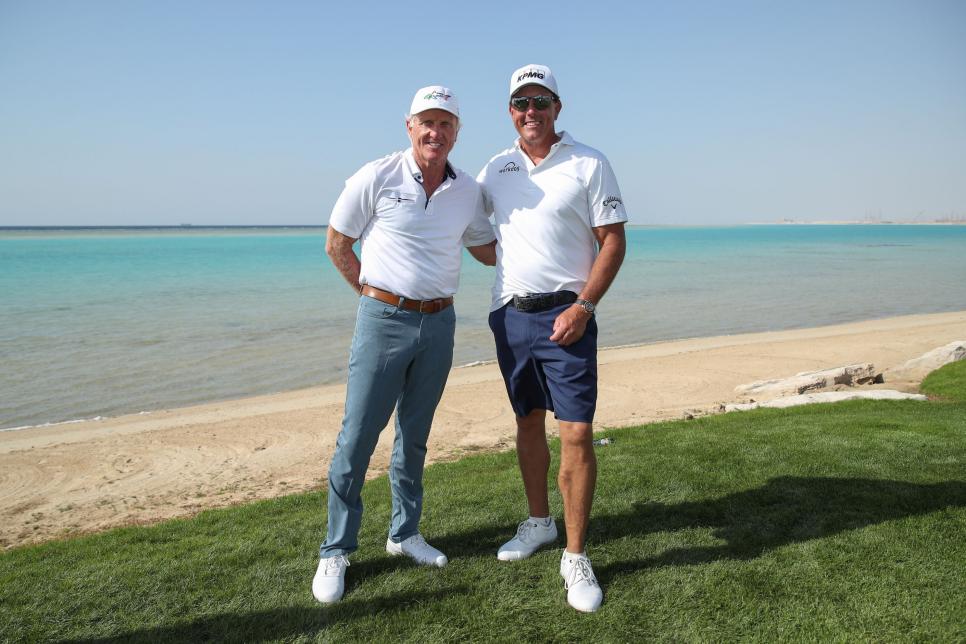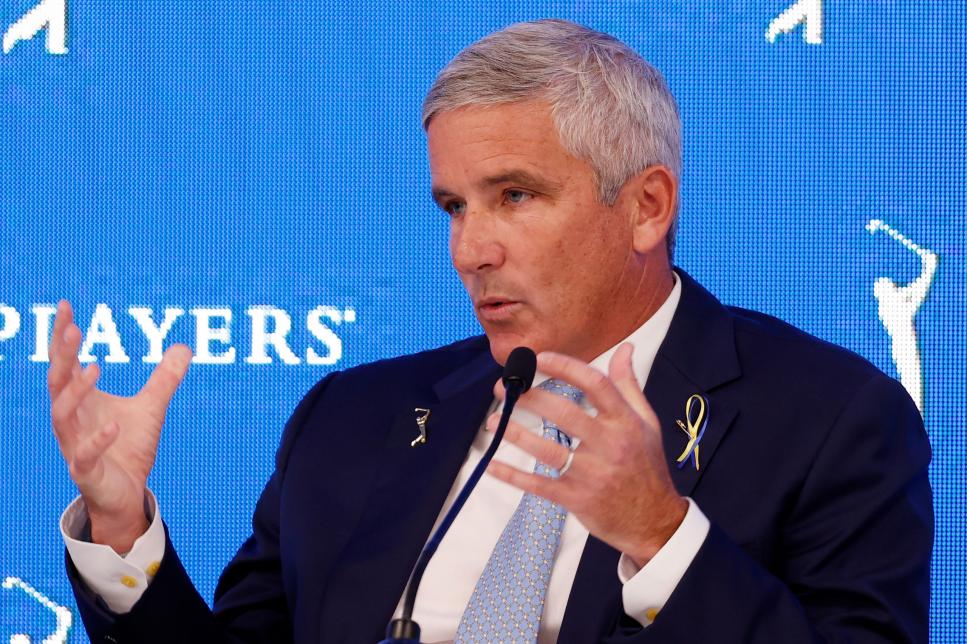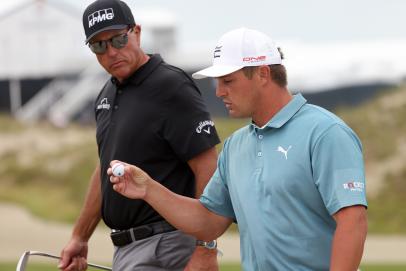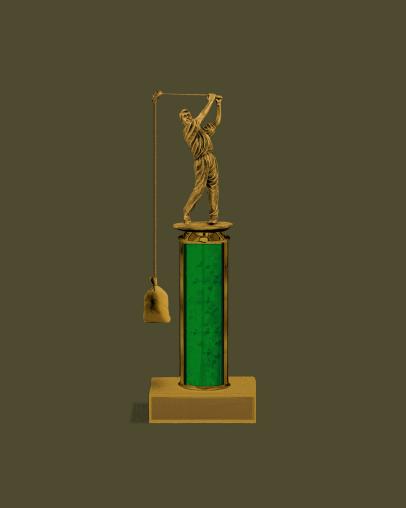News & Tours
The two looming deadlines most likely to trigger a court fight between LIV Golf and the PGA Tour

For weeks the bitterness between officials at the PGA Tour and LIV Golf Investments has simmered, each side looking to improve its position in a multiyear game of cat-and-mouse that looks to be moving, inevitably, toward a battle not on the golf course but in court.
Last Monday marked 45 days until the first round of the first event on the LIV Golf Invitational Series at the Centurion Club outside London, a key date in that the PGA Tour requires any members interested in playing in the tournament to apply for a conflicting-event release by then. Organizers confirmed to Golf Digest that 15 players in the top 100 of the World Ranking—including Phil Mickelson—and roughly 70 players total have registered for the 54-hole tournament, to be held June 9-11 and feature a 48-man field with guaranteed paydays for each participant. In turn, PGA Tour rules stipulate that the tour must decide whether to grant those releases at least 30 days before the event, which would be May 10.
Much has been made about LIV Golf’s inaugural event, set for the same week as the RBC Canadian Open, which returns to the PGA Tour schedule for the first time since 2019 after pandemic issues canceled the event in each of the past two years. And while the Centurion event carries significance as the first of its kind, it’s actually not the tournament that golf insiders are focused on. Rather it’s the second event on LIV’s schedule—July 1-3 at Pumpkin Ridge Golf Club outside Portland, Ore.—that is the one that looks likely to get the lawyers involved.
To understand why, it’s important to note the distinctions between the LIV events—more specifically where they’re being held and what tournaments they compete with on the PGA Tour—and how the PGA Tour bylaws treat them in different ways.
According to multiple sources, the PGA Tour, which has stayed silent on recent rumblings regarding LIV’s plans and declined to speak for this story, could grant releases for the first event because it is being held outside the United States. The PGA Tour granted all releases for the Saudi International in February, an Asian Tour event funded by the same group as LIV Golf (the Saudi government’s Public Investment Fund), but did so with future requirements for the players and emphasized that the decision was not precedent-setting.
The Centurion event differs from the Saudi International in that it is not part of an Official World Golf Ranking-sanctioned tour. In fact, it is not being run by a “tour” at all; while LIV and its CEO Greg Norman had an initial vision for a breakaway tour, this first event is being promoted as an independent entity. Additionally, LIV is not asking players to commit to any of the seven other Invitational series events scheduled for 2022. Their argument: LIV Golf is merely providing options for golfers, who are independent contractors and not employees of the PGA Tour, to ply their trade elsewhere.
“Simply put, you can’t ban golfers from playing golf,” Norman wrote in a scathing letter to PGA Tour Commissioner Jay Monahan in February, shortly after a number of the tour’s top players pledged their loyalty to Ponte Vedra. “Players have the right and freedom to play where we like. I know for a fact that many PGA players were and still are interested in playing for a new league, in addition to playing for the Tour. What is wrong with that?”
Monahan has maintained publicly and in private meetings with players that the tour, even as a 501(c)(6) non profit organization, is well within its rights to make rules for its membership. When it was believed that LIV would ask players to commit to a tour rather than individual events, Monahan said numerous times that any player who commits to the breakaway circuit would face a suspension and potential ban from the PGA Tour.
LIV’s strategic pivot has avoided that scenario, but its release of a schedule has shined a light on the PGA Tour’s conflicting-event release policy. That policy is clearly elaborated in the PGA Tour Handbook, and it is done in a way that allows the tour to consider each request on a case-by-case basis.
The PGA Tour Handbook reads: “The Commissioner shall consider, but shall not be limited to, the following factors:
(1) The overall makeup of the field from which the member seeks to be released;
(2) The member’s standing on the current and previous season’s FedExCup Points List;
(3) The number of tournaments that the member has played in, or committed to play in, for the current season;
(4) The member’s record of participation in the tournament from which he seeks to be released.
That leaves sufficient leeway to issue releases for the Centurion event. But that same leeway does not exist for the LIV event at Pumpkin Ridge, which is scheduled for the same week as the PGA Tour’s John Deere Classic in Silvas, Ill.
The PGA Tour Handbook reads: “NOTE: No conflicting event releases will be approved for tournaments held in North America.” This is cut-and-dry language. If a player applies for a release to play in the Pumpkin Ridge event, he’d have to do so by May 17 (45 days ahead of the first round). Any player would then be denied the release no later than June 1.

PGA Tour Commissioner Jay Monahan said at the Players Championship in March that tour is moving on and focus on its own future rather than worrying about actions from LIV Golf.
Cliff Hawkins
Should that player enter and play in the LIV event regardless, he would likely face punishment from the PGA Tour. At the Players Championship, Monahan said it was time for the tour to move on and focus on its own future, and the tour’s subsequent actions (or lack thereof) suggest an unwillingness to engage with LIV head-to-head.
It is likely that the tour’s blanket ban on competing North American events would then be challenged legally, either by LIV Golf Investments or an individual player.
“That is at least what each party seems to want the other to believe,” says Darren Heitner, a sports law expert who teaches at the University of Florida, “that it is willing to enforce its rights in a court of law and to spend a significant amount of time and resources on counsel.”
The crux of a hypothetical, but seemingly inexorable, case, Heitner says, is “whether the PGA Tour is unfairly and illegally restraining the player from engaging in the player’s trade.” Golf Digest’s Joel Beall dove into both sides’ arguments earlier this year. LIV and Norman have argued that the players’ status as independent contractors enables them to work where they please, but not every legal expert agrees.
“Typically, employers have greater latitude with regard to independent contractors versus employees—hence, the ‘independent’ part of being a contractor,” attorney Tom Allen, who practices in litigation and labor services areas, told Beall. “Here, the focus will be on what powers the PGA Tour can exercise overall with regard to its members, and that shouldn’t depend on ‘employee’ versus ‘independent contractor’ status.”
The Federal Trade Commission dove into the PGA Tour’s regulations in the early 1990s, around the same time Norman tried to start a breakaway World Golf Tour that, like the LIV Invitational Series, aimed to hold events in and out of the U.S. and offer guaranteed lucrative paydays. After a four-year investigation into antitrust claims, the FTC recommended federal action, although none was ever taken, largely due to the skillful workings of then-PGA Tour commissioner Tim Finchem and the tour’s successful lobbying.
Norman remains optimistic that, nearly 30 years later, another challenge could yield different results. In the previously mentioned letter to the PGA Tour, Norman cites an article penned by the chief lawyer for the Federal Trade Commission as evidence of the tour’s precarious footing.
“Let’s be clear: A lifetime ban is never going to happen,” the article states. “PGA Tour Commissioner Jay Monahan is no doubt being advised by high-priced lawyers who—if they are worth even a fraction of their lofty rates—have surely advised him of the legal consequences that will blow up in the PGA Tour’s face if it imposes lifetime bans on independent contractors who choose to associate with a competitor.”
Emboldened by that belief, Norman opened his letter with a now infamous line: “Surely you jest. And surely, your lawyers at the PGA Tour must be holding their breath.”
Holding their breath for two reasons. One, the legality of a potential ban. Two, the tour’s tax-exempt status, which some have suggested could be in jeopardy. The tour’s lawyers will likely argue that the tour is not preventing players from associating with a competitor—they cannot prohibit players from competing in LIV Golf events—but merely restricting them from playing both circuits, and that the law permits them to do so. All 501(c)(6)s are subject to the Sherman Act, enacted to protect free competition and prohibit monopolies, but Allen believes 501(c)(6)s are operating legally so long as their actions are taken to benefit the association or its line of business, and maintaining its position as the premier golf tour in the world would seem to fall within that definition.
“To lose that status, the PGA Tour would have to do something to benefit one individual as opposed to its line of business, and I do not believe a ban of a player or players falls into this category,” Allen told Beall.
Both sides believe the law is with them. The Pumpkin Ridge event—and with it the dates of May 17 and June 1—look increasingly like the catalyst toward determining who is right.







